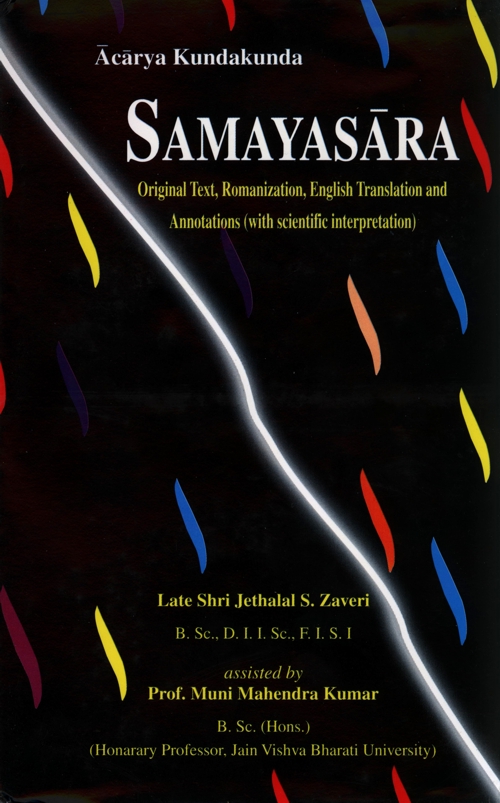
jaha phalihamaṇῑ visuddho ṇa sayaṃ pariṇamadi rāgamādῑhiṃ.
raṃgijjadi aṇṇehiṃ du so rattādῑhiṃ davvehiṃ..42

evaṃ ṇāṇῑ suddho ṇa sayaṃ pariṇamadi rāgamādῑhiṃ.
rdgijjadi annehim du so rdgddlhim dosehim..43

ṇa vi rāgadosamohaṃ kuvvadi ṇāṇῑ kasāyabhāvaṃ vā.
sayamappaṇo ṇa so teṇa kārago tesi bhāvāṇaṃ..44

rāgamhi ya dosamhi ya kasāyakammesu ceva je bhāvā.
tehiṃ du pariṇamaṃto rāgādῑ baṃdhadi puṇo vi..45

rāgamhi ya dosamhi ya kasāyakammesu ceva je bhāvā.
tehiṃ dupariṇamaṃto rāgādῑ baṃdhade cedā..46
(Jaha phalihamaṇi visuddho) Just as jewel is pure and colorless, (rāgamādῑhiṃ sayaṃ ṇa pariṇamadi) and does never becomes tainted with red etc. (du so aṇṇehiṃ rattādῑhi davvehiṃ raṃgijjadi) but appears to assume red tints from other red objects.
(Evaṃ ṇāṇῑ suddho) Similarly an enlightened sage is pure by itself (rāgamādῑhiṃ sayaṃ ṇa pariṇamadi) and does not become transformed into attachment etc., (du so aṇṇehiṃ rāgādῑhi dosehiṃ rāgijjadi) but appears to assume attachment etc. because of infection by alien objects.
(Ṇāṇῑ ṇa vi rāga-dosa-mohaṃ kasāyabhāvaṃ vā sayaṃ appaṇo kuvvadi) An enlightened sage does not assimilate in itself—attachment, aversion, delusion or passions; (teṇa so tesi bhāvāṇaṃ kārago ṇa) that is why it does not become the producer (karta) of these dispositions.
(Rāgamhi ya dosamhi ya kasāya-kammesu ceva je bhāvā tehiṃ du pariṇamaṃto) [The unenlightened soul] determines its dispositions affected by the [rise and fruition of] attachment, aversion, passions and karma; (rāgādῑ puṇo vi baṃdhādi) [consequently] repeatedly undergoes bondage of attachment and the like.
(Rāgamhi ya dosamhi ya kasāya-kammesu ceva je bhāvā tehiṃ du pariṇamaṃto) [the rise and fruition of] attachment, aversion, passions and (dravya) karma produce dispositions of attachment etc. (cedā rāgādῑ baṃdhade) and these dispositions produce the bondage [creating a vicious circle].
Annotations:
In these verses, the author emphasizes that the main obstacle in the path of self-realization is rāga which means affection, attachment, desire etc. He concludes that eradication of affection from conduct leads to self-realization.
Earlier, we had seen that there can be no bondage in the absence of bhāva karma. Desire, affection etc. create vicious circle—the fruition of dravya karma leads to affective states of the soul [which is bhāva karma] and the affective psychic propensities become the condition for new bondage and the cycles go on ad infinitum.
The author uses a simple analogy to underline the intrinsic purity—desireless state of the soul. Just as a sphaṭika (crystal) which is pure and colorless by itself, appears to be colored red [or blue or green] if it is associated with red [or blue or green] coloured external object. Much in the same way, the soul itself is inherently pure and inaffective but appears to be affective etc. as a result of the rise of desire etc.
An enlightened sage (vῑtarāga) becomes free from delusion and is unaffected by attachment, aversion and the like and that is why a vῑtarāga is totally free from bondage of karma. On the other hand, he who is overwhelmed by the rise of attachment, aversion and passions and cannot become free from desire becomes a victim of bondage of colour.
For self-realization, self and self alone is the goal. Anything other than self, as an ideal, would lead away the self from the path. Darśana, jñāna and conduct when conditioned by objects other than self may, in a way, lead to bondage. But if they are determined absolutely by self, then they form the direct antecedent of emancipation. From this it is clear that self-realization cannot be achieved by having even slightest attachment to external objects. Hence, the author emphasizes the importance of the effort to transcend even subtlemost kind of attachment. When the relation of the self to alien objects, either through attachment or ownership, is severed, then there is no possibility of desire springing up in the heart. No desire means no spiritual discord; spiritual harmony repels karma and prevention of karma means end of saṃsāra i.e. emancipation. One who has the ideal of self-realization must, therefore, completely eradicate every kind of desire from his heart.
The essential ingredient of the direct and immediate path to self-realization is the state of vῑtarāga or non-attachment and freedom from desire. This is the meaning of the above verses and the same is the purport of the whole chapter.
 Jethalal S. Zaveri
Jethalal S. Zaveri
 Prof. Muni Mahendra Kumar
Prof. Muni Mahendra Kumar

